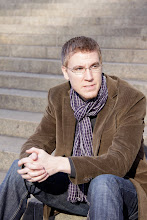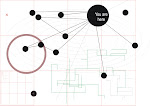Mircea Eliade, the renowned religious historian, spoke of the axis mundi as the sacred cosmic center connecting heaven and earth as distinct from the secular world. [1] Often the axis mundi has been reflected in religion and mythology as a pole or tree, Jewish and Christian traditions has also tended to utilize the axis mundi in the Genesis narrative as the original Garden and the Tree of Life in particular, as well as the temple as the pathway between heaven and earth. Christian traditions would also place the cross in this same avenue of thought as the sacred tree that restored humanity to God.
The Christian landscape is oriented, first and foremost, around the Christ-event: the incarnation. Yet, the physical or geographical spaces in which we encounter the Christ anew, in our ongoing salvation, retain for us special significance associated with the revelatory event. Sacred geography is sacramentally rooted in Christ enabling the geographical landscape to become a tangible record of our spiritual journey. Places and things become holy where we have met the incarnate Axis Mundi. They become an axis of access where God takes the initiative to establish a personal and historic covenant.
It is these places which linger in my memory and are invigorated by my imagination. And it is to further the discussion of the roles that place, memory, and imagination play in our lives that this blog is dedicated to.
[1] Mircea Eliade (The Sacred & Profane: The Nature of Religion (San Diego: Harvest Book, 1957), 53. Jon Pahl also suggests that while Eliade’s conception of sacred space as “hierophany” or manifestation of the holy is still widely used, it has also come under significant critique. Beyond the critique of origination for sacred spaces, Eliade’s second step of orientation remains a very helpful aspect from his thought (Jon Pahl, Shopping Malls and other Sacred Spaces: Putting God in Place (Grand Rapids: Brazos Press, 2003), 45-48.).
skip to main |
skip to sidebar


An axis of access is a sacred place which our life revolves around. We hold them dear in our memory. They thrive in our imagination. They root us to this world. (To read more about the nature of this blog read the originating post from 08.07.07)
About Me

- rstander
- Grand Forks, ND, United States
- i am recent MFA grad from University of North Dakota. while i have range of interests, my ongoing research continues to explore the nature of place/space through artistic and liturgical lenses.
Blog Archive
-
▼
2007
(58)
-
▼
August
(10)
- Questioning God IV - Psalm 6
- Questioning God pt. III
- Questioning God pt. II
- the Trumpet Child
- Breadbasket Profanity?
- Questioning God
- March of the Penguins
- Last week I had the opportunity to visit one of my...
- One of the places I consider sacred is St. Patrick...
- Mircea Eliade, the renowned religious historian, s...
-
▼
August
(10)
Labels
- abandonment
- aesthetics
- architecture
- Art
- artists
- books
- canada
- cartography
- commodified memory
- consumerism
- contested space
- CTS-AAR Photos
- Devotions
- Elevator Series
- Film
- graffiti
- individualism
- iowa
- kitsch
- lectionary readings
- liturgy
- Luke
- Mark
- minnesota
- misc.
- misc. education
- Montana
- music
- nationalism
- new topographics
- North Dakota
- northwestern college
- photographers
- photography
- pilgrimage
- PKAP
- priests in film
- printmaking
- Psalms
- questioning God
- religion as a chain of memory series
- retro signage
- sacred space
- saskatchewan
- scripture
- shoes
- sioux falls seminary
- south dakota
- stray shopping carts
- TH 541
- theological musings
- threshold series
- University of North Dakota
- Video
- visiting artists
- weather reports
Explore
- University of North Dakota
- Sioux Falls Seminary
- Northwestern College
- The Chronicle of Higher Education
- Inside Higher Ed
- College Theology Society
- Image Journal
- Christians in the Visual Arts (CIVA)
- College Art Association
- National Association of Baptist Professors of Religion (NABPR)
- American Academy of Religion
- The Ekklesia Project
- Speaking of Faith
- NT Wright Page
- Textweek.com
- Good Shepherd Episcopal
- Internet Movie Data Base (IMDB)
- The Simpson's
Exhibition Opportunities
Theology & The Arts
Theology and the Arts Academic Programs
My Blog List






